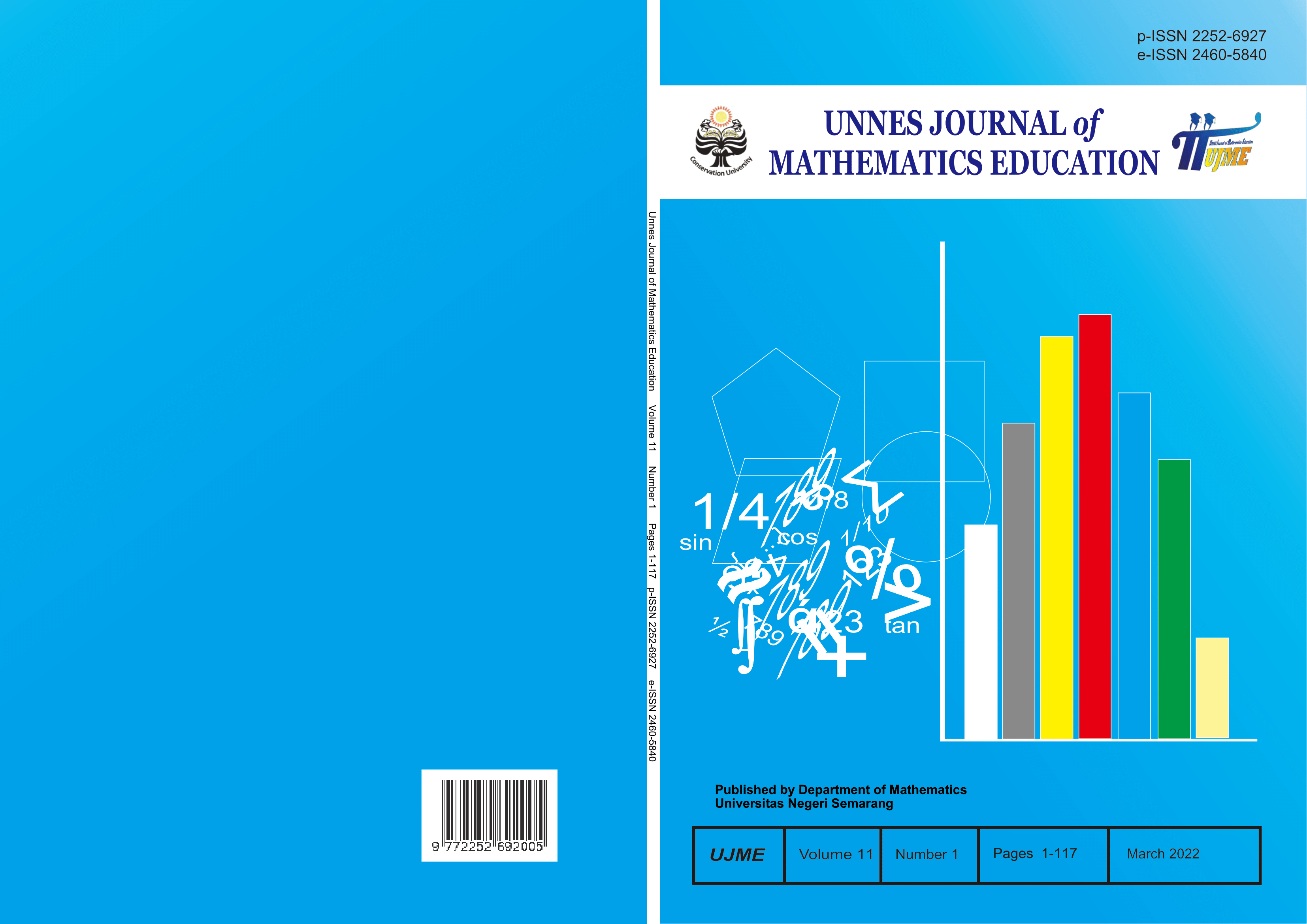Development of STEM-Based Learning Tools to Increase Students' Mathematical Creative Thinking Ability through Inquiry Learning
##plugins.themes.academic_pro.article.main##
Abstract
This study aims to produce appropriate STEM nuanced learning tools on number material and find out the increase in students' mathematical creative thinking skills after the implementation of learning using STEM nuanced learning tools with inquiry learning models on number material. This study used the Research and Development (R&D) method. The R&D steps in this research are potential and problems, data collection, product design, product validation, testing, and the final product. The population in this study were students of class VII of SMP Negeri 8 Semarang, while the subjects in this study were students of class VII-F of SMP Negeri 8 Semarang, totaling 28 students. Data was collected using tests and questionnaires. The increase in mathematical creative thinking skills was analyzed using the N-Gain test from pretest and posttest data. The results showed that the learning tools with STEM nuances with the inquiry learning model developed had a decent level of feasibility, and there was an increase in students' mathematical creative thinking skills on each indicator after being given learning using STEM nuanced learning tools with inquiry learning models with moderate improvement criteria.
##plugins.themes.academic_pro.article.details##
References
Akbar, S. 2013. Instrumen Perangkat Pembelajaran. Bandung : Remaja Rosdakarya.
Ayllon, M., Gomez, I., Ballesta-Claver, & Julio. (2016). Mathematical thinking and creativity through mathematical problem posing and solving. Propósitos y Representaciones, 4(1).
Beswick, K., & Fraser, S. (2019). Developing mathematics teachers’ 21st century competence for teaching in STEM contexts. ZDM - Mathematics Education, 51(6).
Bicer, A., Lee, Y., Perihan, C., Capraro, M. M., & Capraro, R. M. (2020). Considering mathematical creative self-efficacy with problem posing as a measure of mathematical creativity. Educational Studies in Mathematics, 105(3).
Fatah, A., Suryadi, D., Sabandar, J., & Turmudi. (2016). Open-ended approach: An effort in cultivating students’ mathematical creative thinking ability and self-esteem in mathematics. Journal on Mathematics Education, 7(1).
Gonzalez, H. B., Kuenzi, J., & White, D. (2014). What Is STEM Education and Why Is It Important? Florida Association of Teacher Educators Journal, 1(14).
Hershkowitz, R., Tabach, M., & Dreyfus, T. 2017. Creative reasoning and shifts of knowledge in the mathematics classroom. ZDM - Mathematics Education, 49(1). https://doi.org/10.1007/s11858-016-0816-6.
IEA. 2012. TIMSS 2011 International Results in Mathematics.
Jules, T., & Cebold, K. (2018). The Internationalization of Creativity as a Learning Competence. The Internationalization of Creativity as a Learning Competence. Global Education Review, 5.
Kelley, T. R., & Knowles, J. G. (2016). A conceptual framework for integrated STEM education. International Journal of STEM Education, 3(1). DOI: https://doi.org/10.1186/s40594-016-0046-z.
Kwon, O. N., Park, J. S., & Park, J. H. (2006). Cultivating divergent thinking in mathematics through an open-ended approach. Asia Pacific Education Review, 7(1).
Ministry of Education and Culture. 2016. Regulation of The Ministry of Education and Culture No 22 of 2016 about Standar Proses Pendidikan Dasar dan Menengah.
Muzanni, A., & Muhyadi, M. (2016). Pengembangan Perangkat Pembelajaran Problem Solving Mata Pelajaran IPA Terhadap Hasil Belajar Kognitif Siswa SD. Jurnal Prima Edukasia, 4(1).
National Education Standard Board. 2006. Permendiknas No. 22 Tahun 2006 tentang Standar Isi untuk Satuan Pendidikan Dasar dan Menengah. Jakarta : Depdiknas.
Nakano, T. de C., & Wechsler, S. M. (2018). Creativity and innovation: Skills for the 21st century. Estudos de Psicologia (Campinas), 35(3).
OECD. 2019. PISA 2018 Results Combined Executive Summaries Volume I, II, & III.
Partnership for 21st Century Skills. 2008. 21st Century Skills. Education & Competutuveness: A Resource and Policy Guide. New York: ERIC Clearinghouse on Urban Education.
Rochmad, Agoestanto, A., & Kharis, M. (2018). Characteristic of critical and creative thinking of students of mathematics education study program. Journal of Physics: Conference Series, 983(1). https://doi.org/10.1088/1742-6596/983/1/012076
Sahin, A., Ayar, M. C., & Adiguzel, T. (2014). STEM related after-school program activities and associated outcomes on student learning. Kuram ve Uygulamada Egitim Bilimleri, 14(1).
Sebastian, J., & Huang, H. (2016). Examining the relationship of a survey based measure of math creativity with math achievement: Cross-national evidence from PISA 2012. International Journal of Educational Research, 80.
Suarez, Á., Specht, M., Prinsen, F., Kalz, M., & Ternier, S. (2018). A review of the types of mobile activities in mobile inquiry-based learning. Computers and Education, 118.
Sudijono, A. 2011. Pengantar Statistika Pendidikan. Jakarta : PT Raja Grafindo Persada.
Sugiyono. 2018. Metode Penelitian Pendidikan (Pendekatan Kuantitatif, Kualitatif, R&D). Bandung: Alfabeta.
Sundayana, R. 2015. Statistika Penelitian Pendidikan. Bandung : Alfabeta.
Titikusumawati, E., Sa’dijah, C., As’ari, A. R., & Susanto, H. (2019). An Analysis of Students’ Creative Thinking Skill in Creating Open-Ended Mathematics Problems through Semi-Structured Problem Posing. Journal of Physics: Conference Series, 1227(1).
